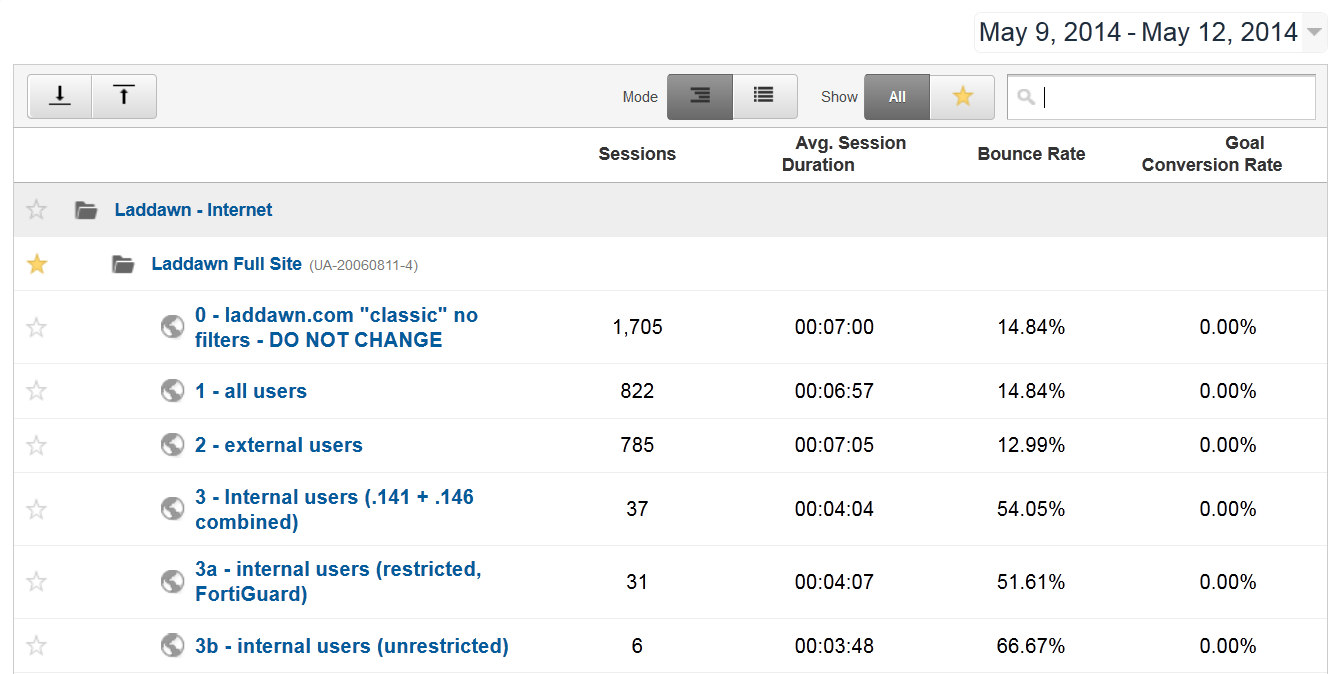Some tips on the data - definitions and limitations
Out of the box, it's all pageview driven; misses activity that happens on a single page (for example, progressing through custom quoting). In order to capture event-driven data, we need to perform some extra instrumentation.
Key concepts
Users (formerly "visitors") - not truly unique people. Every browser/device combo counts as a "user." So if I visit Laddawn on my iPad/Safari and my work computer/Firefox, I am counted as two users.
Sessions (formerly "visits") - period of time user actively engaged with your site. Can consist of single pageviews (+ events when tracked) or multiple. By default, sessions end after 30 minutes of inactivity. If I open a page, leave for 15 minutes, and come back and click to other pages for the next 30 minutes, that is a 45 minute session.
Unique visitors -
Bounce rate - % of single page visits (entrance page = exit page).
Establishing the foundation for meaningful data
- Segmentation of traffic
- Normalization - merge identical upper/lowercase hits; merge homepage laddawn.com + laddawn.com/default.aspx hits; etc.
- Investigate other anomalies and address as necessary - for example, pageviews with unfamiliar URLs
Segmentation of traffic by internal v. external users
Internal users = traffic coming from Laddawn employees, using Laddawn networks. Based on IP address captured by GA.
Further broken down by restricted/unrestricted users - all staff at all Laddawn locations pass through one of two IPs. Staff who have restricted internet access reach the Internet through one IP; staff whose access is unrestricted/less restricted ? pass through another IP.
External users - excludes the traffic coming from the two Laddawn IPs. Note: This will include traffic coming from Laddawn staff working remotely - the IP captured comes from the user's ISP (e.g. Comcast.net) and will vary from user to user, and most likely vary from day to day since ISPs tend not to assign static IPs to individual customers ? To my knowledge at this time, there is no straightforward way to filter these users.
How do we want to define success?
- Google Analytics will be the source for some, but not all of the data to measure these success indicators.
- Practice with current site.
Increased sales
- Overall
- Specific products/product categories
- Purchases by new customers
Increased efficiency
- By CE staff - turnaround times
- More customer self-service
- Faster task completion by both CE and customers
Improved accuracy
Increased sales opportunities through data mining insights
Increased engagement
- Stickiness" (More time? Tricky - more time not always an indicator of a positive experience.)
- Future: Narrative thread, numbers of posts, numbers of "likes" and shares; etc.
Increased customer satisfaction
Adoption of new features - share, save, markup
Effectiveness of marketing campaigns - Tweets, Videos, Mailchimp, etc. - require planning and coordination to capture the data
